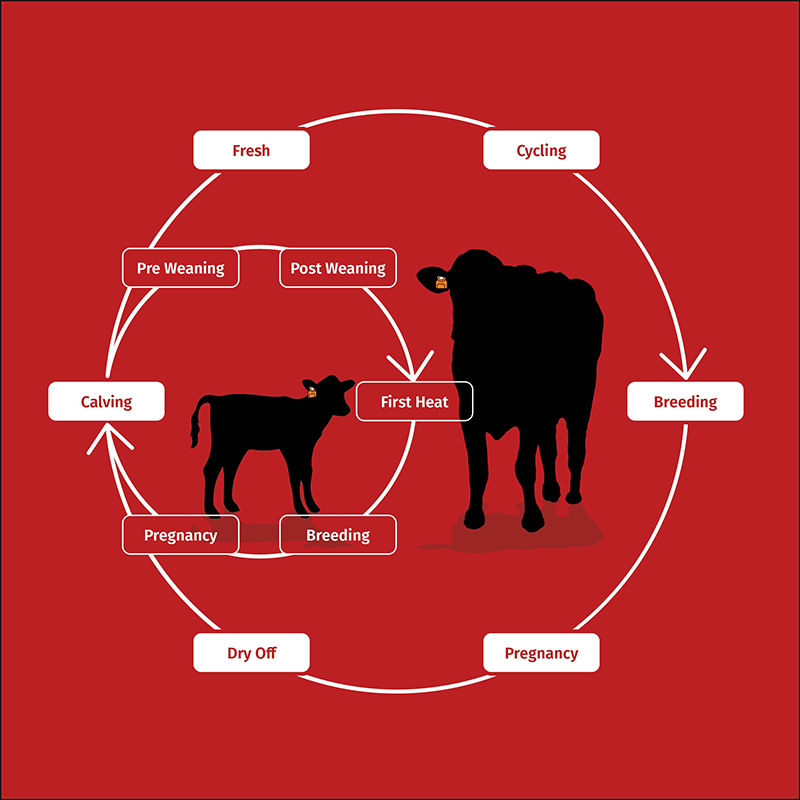In dairy farming, maximizing dairy cow milk production is essential for profitability. More milk in the tank is easier to achieve with a healthy herd. Each cow’s life phase, from calf to cow, comes with its own unique challenges. By closely monitoring the herd, dairy farmers can detect diseases early, reducing the impact of the disease and decreasing the need for antibiotics, and ultimately increasing milk yield. Let’s explore how focusing on health at every development stage leads to better herd performance and higher dairy cow milk production per day.
How to Increase Dairy Cow Milk Production
 Monitor Health Risks in Each Life Stage
Monitor Health Risks in Each Life Stage
Every stage in a dairy cow’s life has potential health risks that can impact overall dairy cow milk production. From respiratory issues in calves to metabolic diseases in lactating cows, recognizing these phase-specific risks is a challenging task. Monitoring from calf to cow 24/7 enables proactive care.
- Calves: In the early weeks, calves are vulnerable to diseases like diarrhea and pneumonia. These conditions can lead to setbacks, affecting future milk production. Monitoring calf health closely enables early treatment, helping calves grow into healthy heifers that contribute to milk yield later.
- Heifers: As heifers grow, reproductive health becomes critical. Diseases such as bovine viral diarrhea (BVD) or infectious bovine rhinotracheitis (IBR) can impact fertility, delaying a heifer’s first calving and affecting profitability and her future milk production per day. Monitoring these risks ensures these heifers are healthy and ready for breeding and eventually the parlor.
- Lactation: Lactating cows face risks from mastitis, ketosis and milk fever, all of which can quickly lower milk yield if not detected in an early stage. Real-time monitoring technology helps identify subclinical signs of these issues, allowing for timely intervention, which can help keep milk production steady.
- Transition: During the transition period, cows are vulnerable to diseases that may affect their next lactation. Issues such as metritis and retained placenta post-calving can delay return to peak milk production per day. Monitoring during this pre-fresh phase and taking timely action supports a smooth transition back into lactation.
Increase Cow Milk Production
Working with data-driven solutions is a modern approach to improving dairy cow milk production. Technologies that monitor cow activity, health and rumination provide dairy producers with real-time insights, ensuring timely intervention. This data can guide management decisions for improving nutrition and overall herd health, which ultimately can help increase dairy cow milk production per day.
Prioritize Health and Comfort to Increase Cow Milk Production
Increasing dairy cow milk production is achievable through a combination of good nutrition, advanced health monitoring, and a focus on reducing stress and improving cow comfort. By integrating these practices and leveraging modern technology, dairy producers can maintain high levels of dairy cow milk production per day. The result is a more productive herd, healthier cows, and a more profitable dairy operation. Get the 5 tips of improving herd health!
The Benefits of Early Detection and Intervention
In the fast-paced world of dairy farming, issues such as sick cows and low milk yields can severely jeopardize the economic potential of the dairy operation. As the industry faces increasing pressures, such as growing public concern over dairy calf and cow welfare, the integration of advanced health monitoring technology has become essential. Examine the role technology can play in improving herd performance and maximizing farm profitability.
Download our briefing now to learn how to maximize performance and your dairy farm profitability today!
DownloadCan’t wait to check out the system?
We could tell you a lot more about our cow monitoring system, but we’d rather show you. Download our Demo App, and we’ll take you on a virtual tour through all the possibilities. Let’s go!